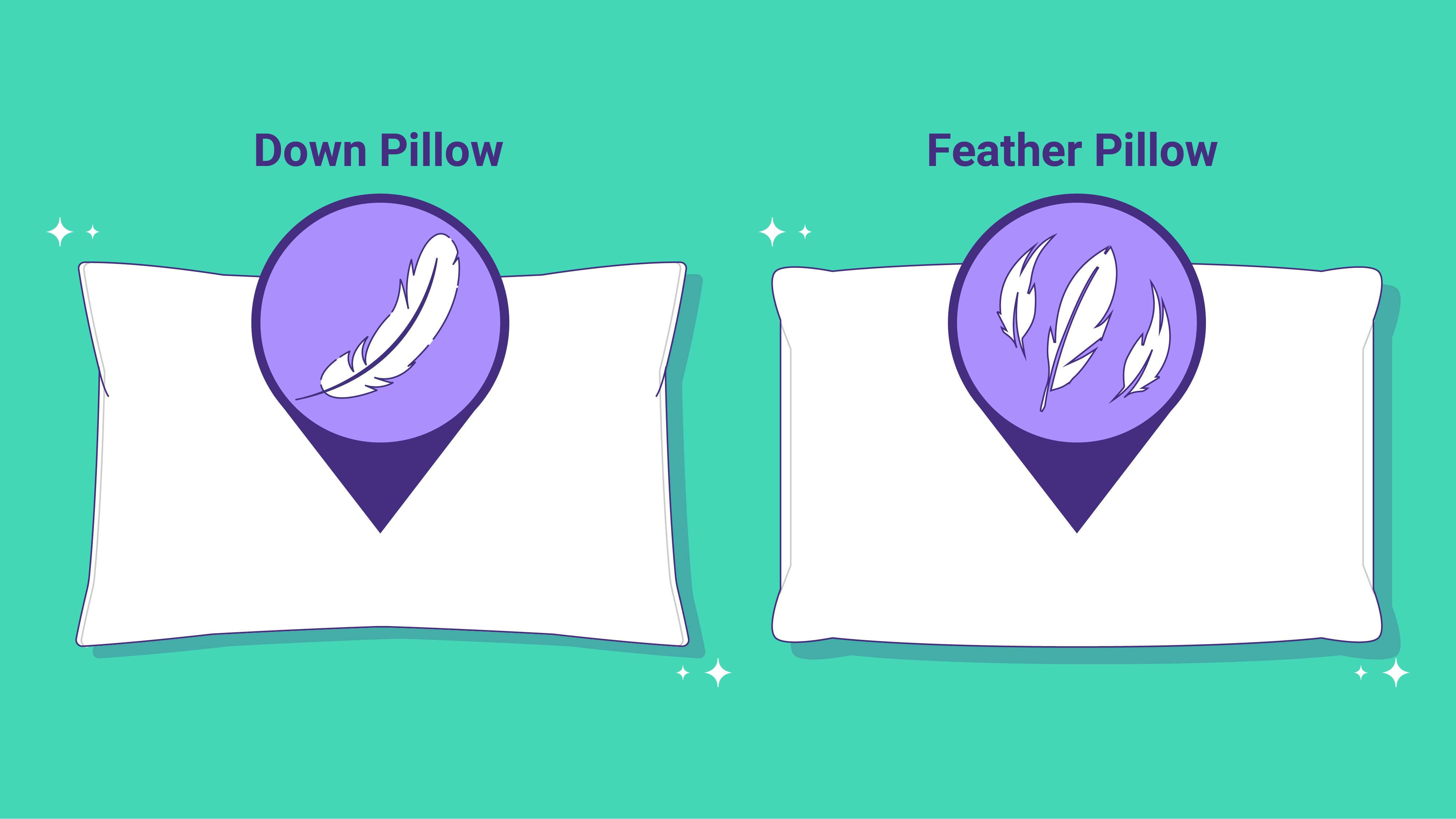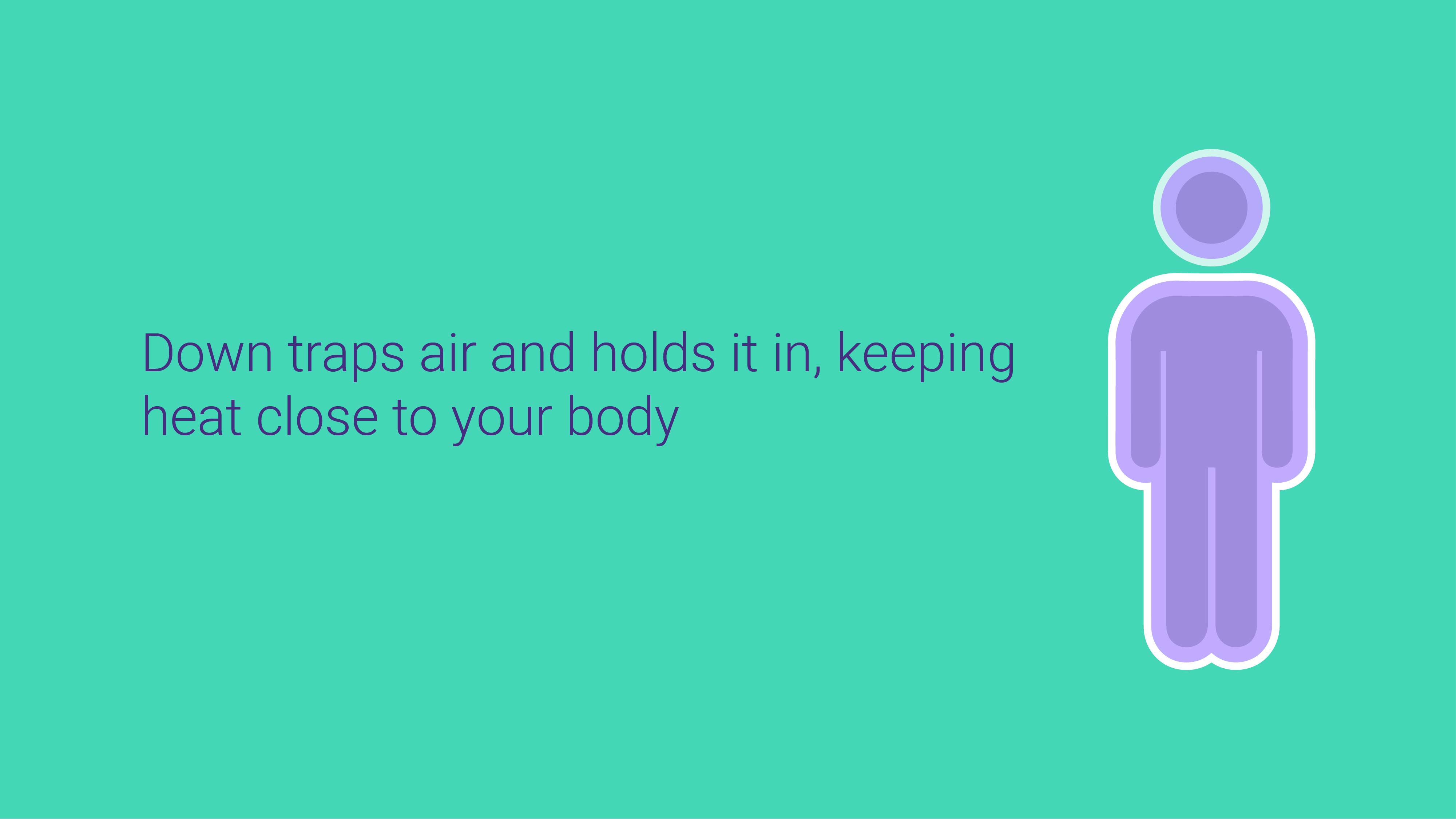
Down vs. Feather Pillow: Which is Best?

- Down and feather pillows are distinct in their composition and characteristics, with down providing a luxurious, fluffy, and lightweight experience, while feather pillows offer sturdier, firmer support and are more resistant to flattening.
- Understanding key terms such as fill power, loft, quill, and fill ratio is essential when evaluating the quality and characteristics of down and feather pillows, enabling you to make informed choices based on your comfort.
- Considerations such as feel, temperature retention, cost, maintenance requirements, durability, sustainability, and specific sleeping needs are crucial factors to evaluate when deciding between down and feather pillows.
Since down is a type of feather, a lot of people think down and feather pillows are the same thing. They’re similar in some respects, like the fact that they both come from geese or ducks. However, these pillows are very different in other aspects. They have different weights, different feels, and different maintenance needs.
Below, we’ll talk about the differences between down and feather pillows. We’ll also discuss how to choose the right one for you.
Down Pillows
Down is a specific type of feather meant to insulate. It occurs under the tougher outer layers of bird feathers, and it helps keep birds warm and dry in any weather. This means down pillows are generally more luxurious than feather pillows. They’re fluffier, lighter weight, and warmer.
Sleeping on a pillow made of down clusters feels like sleeping on a cloud of cotton candy. The down compresses underneath your head’s weight, allowing you to sink into your pillow. Despite this, down is fluffy and can spring back into place.

Feather Pillows
Feather pillows are stuffed with other types of feathers besides down. Typically the feathers for feather pillows come off the birds’ backs or wings. This means they’re tougher, and the pillows made from them offer sturdier, firmer support.
When you lie on a feather pillow, it will put up more resistance because the pillow is denser. However, down clusters naturally want to bounce back to their original shape. That means while feather pillows offer firmer support, they tend to flatten out.
Terms to Know
Before we get into the advantages and drawbacks of feather and down pillows, there are a few terms you should know:
Fill Power
Fill power is the amount of volume one ounce of down takes up. The larger the down cluster, the higher the fill power. Pillows with high fill power can trap more air than lower fill power pillows. That means high fill power pillows are thicker and more insulating than low fill power pillows. Keep in mind fill power only applies to down, not feathers.
Loft
Loft just means the height or thickness of the pillow. Loftier pillows look more substantial when they’re just sitting on the bed. They also resist going flat better than pillows with less loft, so you don’t have to fluff them as much.
Quill
The quill is the rigid shaft of a bird’s wing, tail, or protective outer body feathers. Before the invention of fountain pens, people used the hollow shafts of bird feathers as writing utensils. That’s why we also refer to a pen made from a feather as a quill.
Fill Ratio
Many down and feather pillows contain a little bit of each material. A pure down pillow cannot be called such unless it is 100 percent down. Understanding the exact mix used gives an idea of how the pillow will feel.
For example, many shoppers find a down pillow that is 50 to 80 percent down fill feels perfectly comfortable.
Down vs. Feather Pillows: Advantages and Drawbacks
Down and feather pillows have a lot of similarities and a lot of differences that you need to be aware of before you purchase. We cover how each one stacks up when it comes to different traits to make the search for the best pillow easier.
Feel
Down is soft and fuzzy, and it comes in round clusters. The clusters mean that down pillows have tons of loft. They look very thick when they’re just sitting on the bed.
Down pillows can squish under your weight, taking on your unique shape to offer your head and neck customized support. Since down’s natural tendency is to bounce back to its 3-dimensional shape, it will also spring back to its original loft when you get up in the morning.
Feathers, meanwhile, don’t compress like down. Instead, they resist your weight and offer you more support and less contouring. Since feathers don’t come in clusters, feather pillows need to be fluffed more often so that they don’t flatten out.
Another big problem with feathers is their quills. Since feathers have stiff quills and down doesn’t, feathers may poke through the pillowcase and prick you while you sleep. This can interrupt your slumber if it happens enough.
Temperature
Down evolved to retain heat to protect birds from the cold. Down traps air and holds it in, keeping heat close to your body. This insulation is why things like winter gear and cold-weather comforters are made of down. It keeps you cozier than just about anything else. If you sleep cold, you might prefer down.
Feather pillows sleep cooler than down pillows because they don’t trap heat. That means hot sleepers seeking a cooling pillow will probably prefer feathers over down.
See Also: Feather vs Down Alternative Pillow
Cost
There’s no question—down is expensive. High-quality down fill can cost 2 to 3 times more than feather fill. However, since down lasts longer than feathers, the fact that you’re not replacing your pillows as often can save you money in the long run. That means down has a higher initial cost than feathers, but a lower long-term cost.
Maintenance
Both down and feather pillows can be high-maintenance. But feathers are a bit more challenging to deal with. Feathers cannot get wet, end of story. That means if you want to clean feather pillows, you’ll have to take them to the dry cleaner.
Down, meanwhile, may or may not be machine washable. You should follow your pillow’s care instructions. Sometimes, down can be soak washed in a machine with no agitator. But you should only use down soap or gentle powder detergent when washing a pillow. Never heat dry down.
Whether you have down or feathers, you should always take steps to extend your pillow’s life. Don’t go to bed with oily or wet hair. Use a pillow protector. And wash your pillowcases frequently. Proper care can help prevent your pillow from developing mold and mildew. It can also stave off other allergens like dust, dust mites, and pollen.
Durability
All pillows need to be replaced, and when you can expect to replace them is an important shopping consideration.
When it comes to durability, down is the winner here. Down clusters eventually lose their ability to spring back to their spherical shape, but this takes a long while. Properly maintained down pillows can last up to a decade. Feather pillows, meanwhile, tend to lose their loft and go flat a lot faster than down. Depending on the quality, you may only get a couple of years out of your feather pillow.
Sustainability
Both down and feathers are about equal here. They both come from the same birds, meaning they have similar carbon footprints and produce similar amounts of waste. Down has feathers beat in one key area. Since it’s more durable, you’re not going to create as much garbage with down pillows because you won’t throw them out as often.
However, since down and feathers are natural fills, they’re biodegradable and can make for excellent natural pillows. If you have a down pillow with a natural, biodegradable cover like cotton, then the fact that your pillow will decompose can offset you tossing it in the garbage.
See Also: Down vs Latex Pillow
FAQs
Is a down or feather pillow best for side sleepers?
Side sleepers need the most support and loft of any sleep position, while back sleepers and stomach sleepers need pillows with lower densities. To keep a side sleeper’s spine in neutral alignment, a pillow has to have enough loft and enough firmness to keep your head lifted in line with your body.
Both down and feathers can fit this bill. Down pillows with a high fill power can be thick enough to support side sleepers’ heads, while high-loft feather pillows offer firm support.
Are down or feather pillows machine-washable?
Down can be machine-washable, but feather pillows never are. As long as you wash down cold, on the gentle cycle, in a machine with no agitator or in a bathtub, it should bounce back once it’s done drying.
Feathers are a different story. The feather’s vane (the plumed fibers that grow from the central shaft) may cling to the quill after washing. What’s more, feathers can have trouble drying. If they stay wet long enough, they can develop mold and mildew.
Should I use a down or feather pillow if I have asthma?
Allergy and asthma sufferers might want to consider down alternative over natural down or feathers. Down alternative is made of polyester microfibers, meaning it makes a hostile environment for all kinds of microbes, from mold to dust mites to bacteria. If you have asthma or allergies, down alternative is resistant to most common allergens and can make a good pillow fill for you.
Is down alternative a good option for vegans?
Down alternative is made entirely of polyester, meaning it doesn’t have any animal products and is technically vegan. However, down alternative is not all-natural. Vegans who want pillows without synthetic materials should consider cotton, buckwheat, or kapok as alternatives to both natural and artificial down.
Which is better, goose or duck down for a pillow?
Ducks and geese have similar down feathers, but goose down is considered the gold standard of down. However, while goose down may have a reputation for being better than duck down, the two are actually not that different, though they do have a couple of superficial distinctions.
Geese have larger down clusters because they’re typically larger animals. That means goose down often has higher fill power than duck down. On the other hand, duck down is more available than goose down because people eat more ducks. That means duck down is less expensive than goose down even though it’s of comparable quality. If you want down pillows, either goose or duck down is a great choice.
Bottom Line
Both down and feather pillows are great options if you want a squishy, soft pillow. Down offers ultimate luxuriousness, while feathers offer substance and support. If you seek durable plushness, go for down. And if you desire firmness and weight, feathers may be for you.
